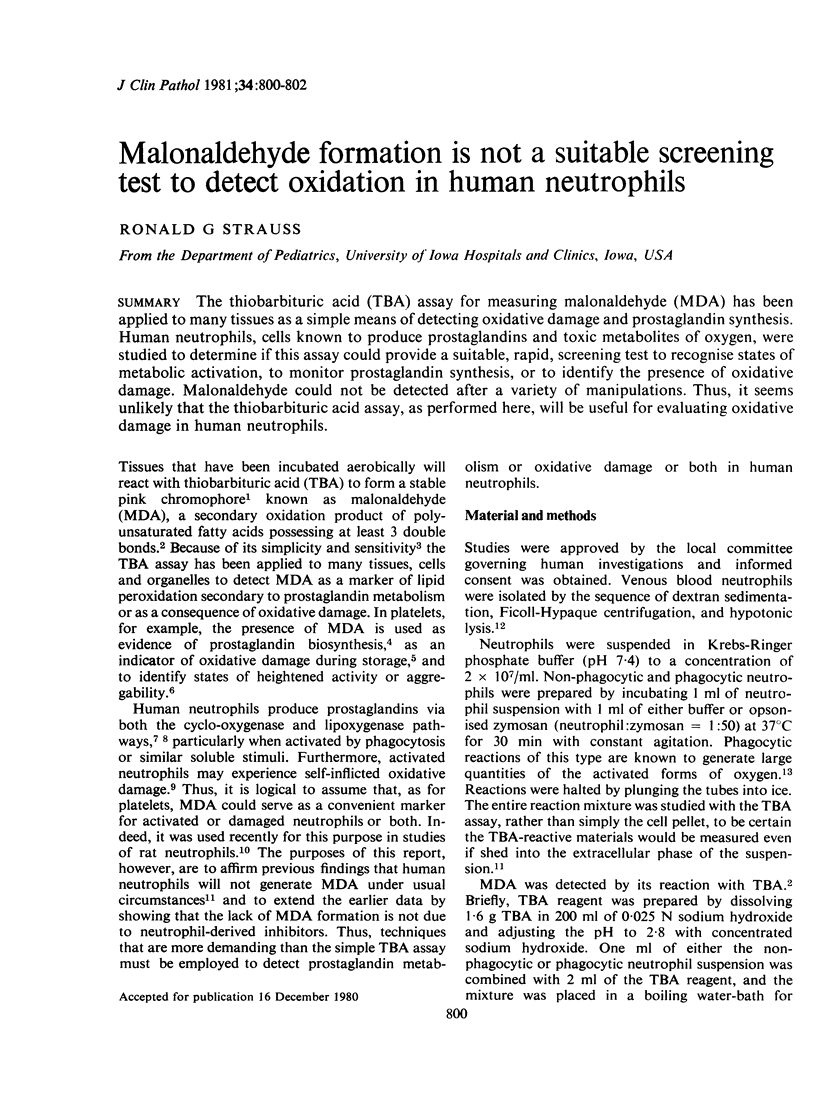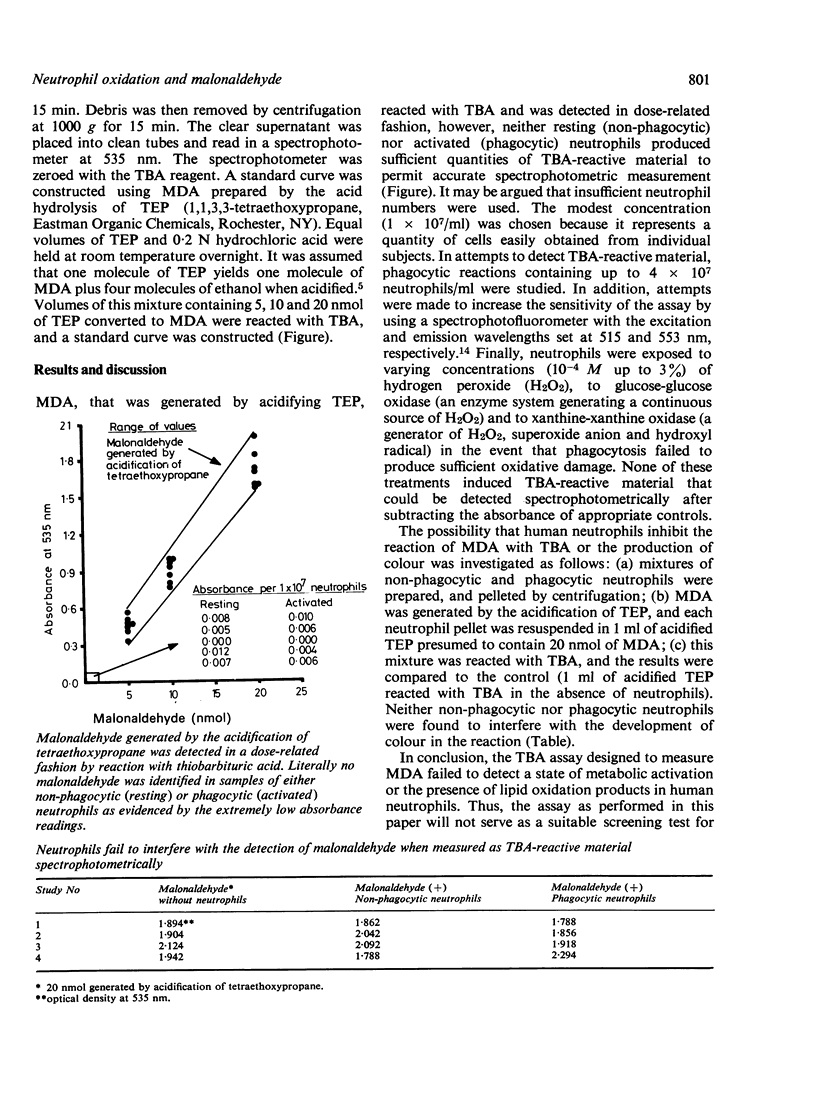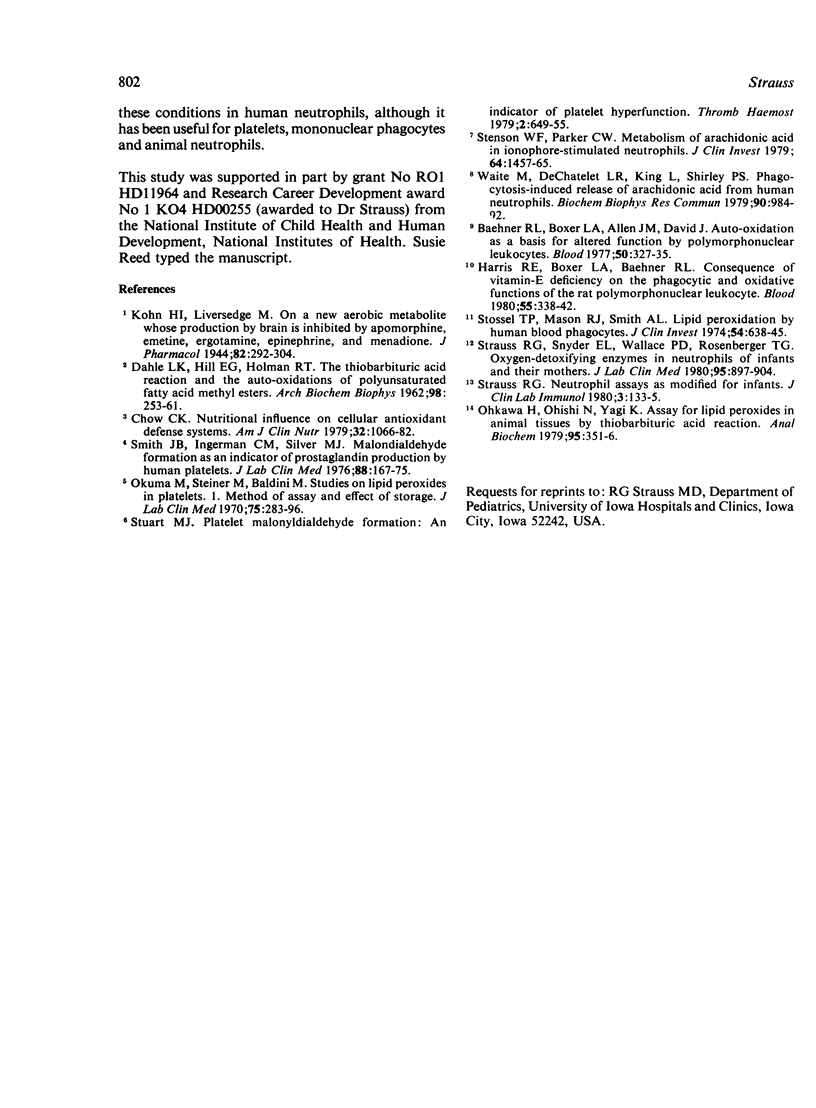Abstract
The thiobarbituric acid (TBA) assay for measuring malonaldehyde (MDA) has been applied to many tissues as a simple means of detecting oxidative damage and prostaglandin synthesis. Human neutrophils, cells known to produce prostaglandins and toxic metabolites of oxygen, were studied to determine if this assay could provide a suitable, rapid, screening test to recognise states of metabolic activation, to monitor prostaglandin synthesis, or to identify the presence of oxidative damage. Malonaldehyde could not be detected after a variety of manipulations. Thus, it seems unlikely that the thiobarbituric acid assay, as performed here, will be useful for evaluating oxidative damage in human neutrophils.
Full text
PDF


Selected References
These references are in PubMed. This may not be the complete list of references from this article.
- Baehner R. L., Boxer L. A., Allen J. M., Davis J. Autooxidation as a basis for altered function by polymorphonuclear leukocytes. Blood. 1977 Aug;50(2):327–335. [PubMed] [Google Scholar]
- Chow C. K. Nutritional influence on cellular antioxidant defense systems. Am J Clin Nutr. 1979 May;32(5):1066–1081. doi: 10.1093/ajcn/32.5.1066. [DOI] [PubMed] [Google Scholar]
- DAHLE L. K., HILL E. G., HOLMAN R. T. The thiobarbituric acid reaction and the autoxidations of polyunsaturated fatty acid methyl esters. Arch Biochem Biophys. 1962 Aug;98:253–261. doi: 10.1016/0003-9861(62)90181-9. [DOI] [PubMed] [Google Scholar]
- Harris R. E., Boxer L. A., Baehner R. L. Consequences of vitamin-E deficiency on the phagocytic and oxidative functions of the rat polymorphonuclear leukocyte. Blood. 1980 Feb;55(2):338–343. [PubMed] [Google Scholar]
- Ohkawa H., Ohishi N., Yagi K. Assay for lipid peroxides in animal tissues by thiobarbituric acid reaction. Anal Biochem. 1979 Jun;95(2):351–358. doi: 10.1016/0003-2697(79)90738-3. [DOI] [PubMed] [Google Scholar]
- Okuma M., Steiner M., Baldini M. Studies on lipid peroxides in platelets. I. Method of assay and effect of storage. J Lab Clin Med. 1970 Feb;75(2):283–296. [PubMed] [Google Scholar]
- Smith J. B., Ingerman C. M., Silver M. J. Malondialdehyde formation as an indicator of prostaglandin production by human platelets. J Lab Clin Med. 1976 Jul;88(1):167–172. [PubMed] [Google Scholar]
- Stenson W. F., Parker C. W. Metabolism of arachidonic acid in ionophore-stimulated neutrophils. Esterification of a hydroxylated metabolite into phospholipids. J Clin Invest. 1979 Nov;64(5):1457–1465. doi: 10.1172/JCI109604. [DOI] [PMC free article] [PubMed] [Google Scholar]
- Stossel T. P., Mason R. J., Smith A. L. Lipid peroxidation by human blood phagocytes. J Clin Invest. 1974 Sep;54(3):638–645. doi: 10.1172/JCI107801. [DOI] [PMC free article] [PubMed] [Google Scholar]
- Strauss R. G. Neutrophil assays as modified for infants. J Clin Lab Immunol. 1980 Mar;3(2):133–135. [PubMed] [Google Scholar]
- Strauss R. G., Snyder E. L., Wallace P. D., Rosenberger T. G. Oxygen-detoxifying enzymes in neutrophils of infants and their mothers. J Lab Clin Med. 1980 Jun;95(6):897–904. [PubMed] [Google Scholar]
- Stuart M. J. Platelet malonyldialdehyde formation: an indicator of platelet hyperfunction. Thromb Haemost. 1979 Aug 31;42(2):649–654. [PubMed] [Google Scholar]
- Waite M., DeChatelet L. R., King L., Shirley P. S. Phagocytosis-induced release of arachidonic acid from human neutrophils. Biochem Biophys Res Commun. 1979 Oct 12;90(3):984–992. doi: 10.1016/0006-291x(79)91924-7. [DOI] [PubMed] [Google Scholar]


